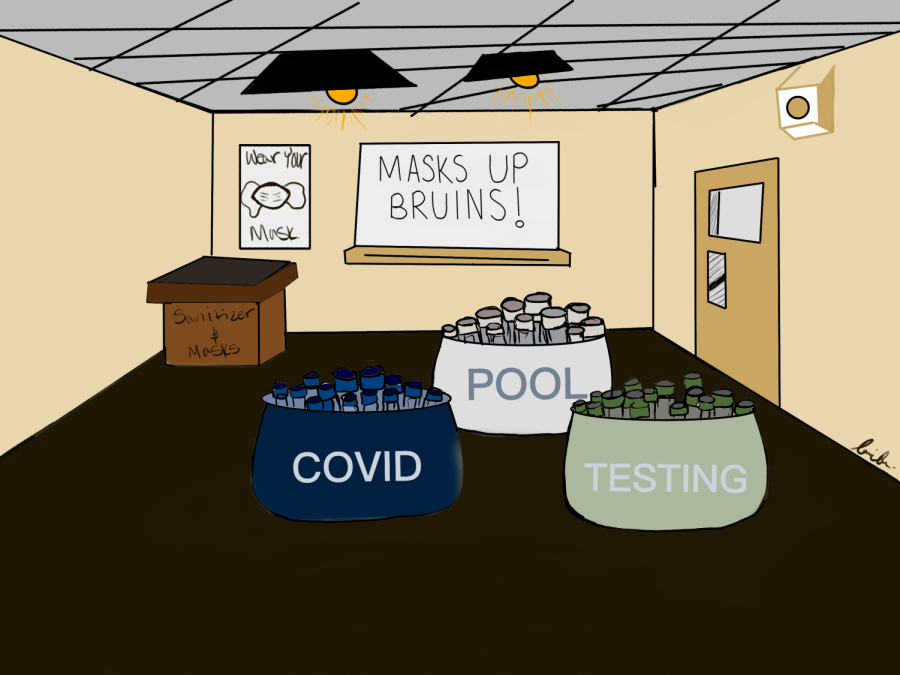OPINION: Pooled testing is an unreliable and inefficient method to prevent the spread of COVID-19
Pooled testing takes place weekly at SCHS, however, the practice wastes resources.
On Aug. 12, 2021, all SCHS students returned to in-person learning for the first time since March of 2020. However, students returned with certain modifications, such as mask mandates, and to prevent the spread of COVID-19, contact tracing and pool testing.
Pool testing is the process of taking nasal swabs from a select group of students and sending all samples to be tested in the same solution. If the solution tests positive for COVID-19, all students tested are immediately given a rapid COVID-19 test. This process is unnecessary, unreliable and a misuse of resources that could be diverted to other services SCUSD is lacking.
Pool testing is a result of a partnership between Concentric, a company that provides the split-pool testing program, and the state of California. The money used in the program could be better put to use by addressing issues existing among Californian schools, such as the lack of an increased budget. According to John Fensterwald, a writer for EdSource, Gov. Gavin Newsom promised a “1.5 percent budget increase for K-12 schools,” which has since been called off. Instead of focusing attention on split-pool testing, money could go toward increasing the school district’s budgets and allowing them to utilize the funds as needed. Pool testing is a political distraction disguised as state funding assistance.
While pool testing may seem like an efficient way to receive results for all participating students, it actively excludes those from less affluent areas. In Santa Clara, for example, students in more affluent areas who are eligible are more likely to be vaccinated and have more opportunities to be conscious of COVID safety, such as at Millikin Elementary School, where caschooldashboard.org reported it is the least socioeconomically disadvantaged school in SCUSD though it has the highest signup rate of the split-pool testing, with a rate of 86.81 percent, per a Sept. 23, 2021 SCUSD slideshow.
If testing is only testing the rates of students more likely to be vaccinated or COVID conscience, testing numbers are supporting a false narrative. Pool testing is not targeting and stopping COVID spread in all schools but instead reinstating the higher success rates of students born to equital privilege. This should not be the case, and students with distinct socioeconomic backgrounds should all have the chance to target the virus’ spread.
Pool testing is also problematic due to its ineffectiveness and potential failure to detect viral RNA. According to Brian Rubin, the Chairman of Pathology at the Cleveland Clinic, COVID-19 tests could become “compromised when adding more samples to a pool” because the more tests added to a solution, the more diluted the solution becomes, making it difficult to detect important COVID-19 RNA. Furthermore, according to the National Academies of Science, Engineering and Medicine, due to the lack of sensitivity in pooled tests, all tests must be “run multiple times to detect and isolate cases,” which is highly ineffective and problematic as it is very possible for the tests to produce false negatives, increasing the likelihood of the prevalence of COVID-19 spread.
One of the most common arguments for split-pool testing is that it is vital for schools to provide testing for students who do not possess the resources to protect themselves from COVID. Instead of split-pool testing, the state should provide underfunded schools with the same opportunities for students and staff to protect themselves from the virus. SCHS provides the resources for students to protect themselves from COVID-19. At frequent locations on campus, there are several ways for students to sanitize their hands whenever closer contact to other students has been made. Moreover, all students are required to wear masks, and in addition to the office, a large number of teachers provide masks for students who need one. Lastly, the school uses contact tracing to target students who might have been exposed to COVID-19, and all students who might have contracted the virus are granted the opportunity to take an immediate rapid point-of-care COVID-19 test, which is where SCUSD should be focusing their attention on, not on split-pool testing.
SCHS’s set COVID-19 prevention practices do not excuse the problematic nature of split-pool COVID testing. In order to help underprivileged students and to save valuable time, SCUSD must abandon the practice of pooled testing and spend time and money to provide more opportunities for students to socially distance and have reliable Chromebooks and internet. Only by doing this, can the school set strong foundations to prevent the spread of COVID-19 and help students succeed academically.


